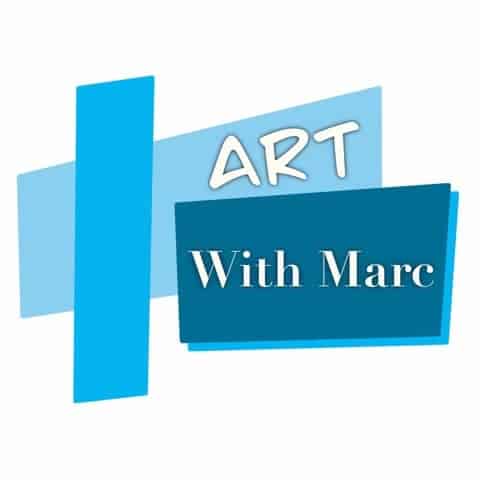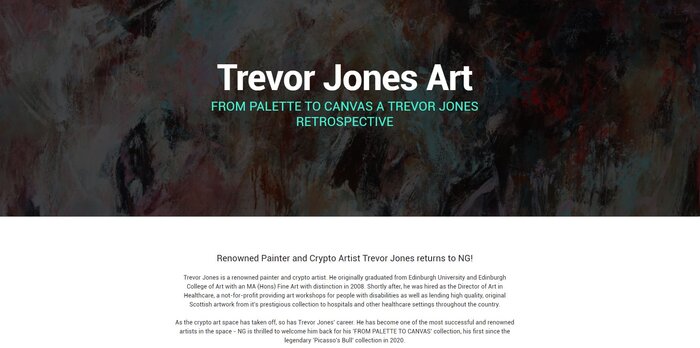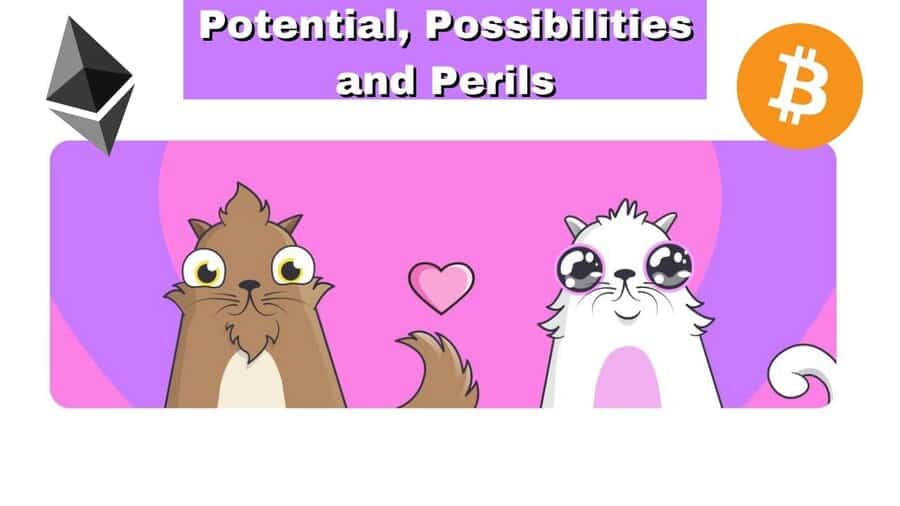
If you spend any time lurking in the various corners of the internet art world, you likely have been bombarded lately with the latest and greatest technological craze hitting the art scene.
NFT Art! They are also commonly referred to as Nifty art.
This naturally brings us to the question, what exactly is NFT Art?
NFT stands for Non-Fungible Token. A nonfungible token exists on the blockchain just like cryptocurrency does. It is used to represent a particular asset or item. Applying a nonfungible token to a digital asset makes that asset exist as a singular unique item that only one person can own. NFT Art is any art that is connected to the blockchain through a Non-Fungible Token.
This is particularly useful to the digital artist or to any particular asset that exists in the digital realm. While right now most of the hype is surrounding the digital art world, NFT’s have a very wide range of fascinating uses.
For the purposes of this article, we will remain focused primarily on their applications in the art world so we can better understand how to use NFT’s in our art careers to make money.
That said, I don’t think I can reframe from mentioning some of the other uses they can have. There are also a number of issues that you should be aware of before participating in this market in ANY WAY! Either as a seller or a buyer.
We will cover those concerns in the last section. So be sure to read until the end! It’s really important!
Before we move on though we should elaborate a bit more on what “the blockchain” is. While you might be familiar with cryptocurrencies like Bitcoin and Ethereum I still find many people do not understand the underlying technology that makes these things possible.
What is “The Blockchain”? What It Means and Why It’s Important
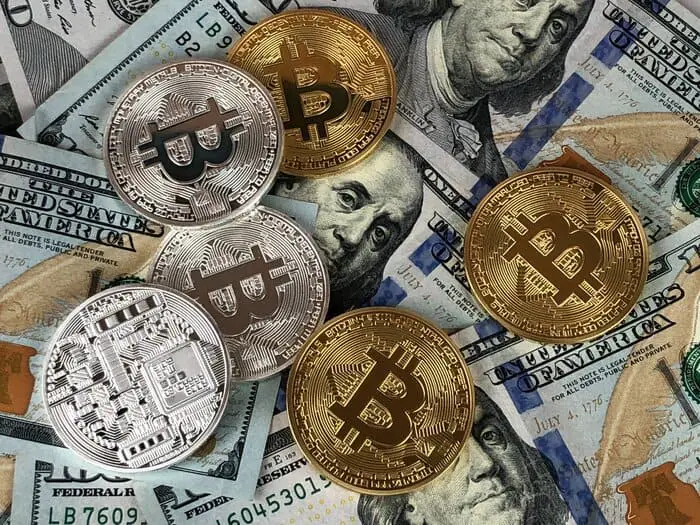
When asking this question on the internet there seems to be a whole host of answers that I feel over complicate the matter with big words and foreign terminology to the average person.
To state it as simply as possible, the blockchain is basically a way of recording transactions and exchanges of valuable items in a way that is unalterable and requires no middle man.
Now, the thing that makes this different from a ledger where we record such things with pen and paper, or something like a spreadsheet, is that this record is stored across a CHAIN of servers.
The record is accessible and visible by everyone and is updated in real-time as transactions are made. Since it is stored on each BLOCK of the chain of ledgers simultaneously, it makes it very difficult to try and alter the record.
A hacker would need to hack every single block connected to the chain because if they change only one the rest of the network would easily be able to see the fraud taking place. On top of that, each block has its own encryption.
As the chain of blocks connected to the network grows, the security of the entire system increases. Making it incredibly difficult to defraud the system.
I want to reframe from going as far as saying it’s impossible as there may be one day where quantum computing and AI technologies make such a thing possible but that day is a ways off still. I could also be wrong about that and speaking out of ignorance.
The point is though no one person is in charge of this network. It is a decentralized way to conduct transactions of valuable assets. It is without a doubt one of the most revolutionary technologies to hit humanity.
It’s as important as the advent of agriculture, the printing press, and even the internet. Perhaps even more than all three combined.
Now that the technology has advanced to the point where Non-Fungible Tokens are possible, it opens up a whole new realm of possibilities that are going to tremendously impact the entire global economy.
Perhaps even the myriad of global political systems as well. I know eventually, the blockchain will be used to make electronic voting possible I’m just not entirely sure NFT’s are the key to that just yet.
They ARE the key to a whole bunch of other incredible possibilities! As stated before they are not without some issues though.
Where To Buy NFT Art?
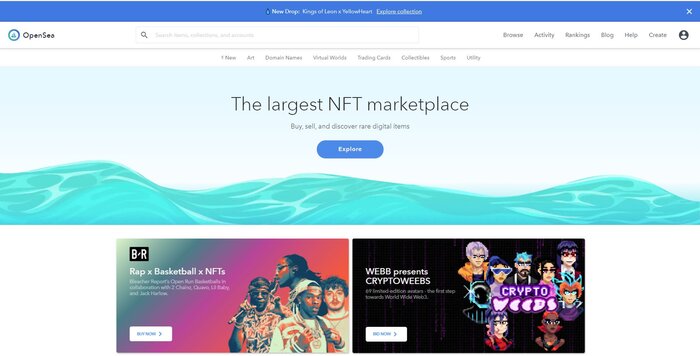
At this point, you may be beginning to wonder where are the places where this Nifty Art is being sold and bought. Before you go buying anything though I have to reiterate that I would highly encourage you to read this entire article or at least the last section that highlights a lot of the major concerns and issues with NFT art.
With that in mind let’s make our next step to understanding this amazing new world of art by simply absorbing and studying what is out there. What are the various market places currently available where you can buy NFT Art?
There are already many and with its explosion in popularity I expect many more to pop up over the next few years. To be clear, there are currently 129 different marketplaces to buy NFT art at the time of writing this.
At least that’s how many are on the list found at the following link.
For the most up-to-date list of NFT Markets visit NonFungible.com by clicking here!
They all have their pros and cons. Which one you want to go to depends on what sort of NFT Art you may be interested in collecting.
Here we will cover some of the top-grossing market places at the time of writing this article. These are the top 10 that did the highest sales in the past week according to NonFungible.com:
- CryptoPunks (larvalabs.com)
- SoRare.com
- Superrare.co
- HashMasks.com
- ArtBlocks.io
- CryptoKitties.co
- MakersPlace.com
- Decentraland.org
- AxieInfinity.com
- ChainGuardians.io
While I can’t cover all of the incredibly wonderful marketplaces that are currently emerging these 10 should open up your eyes to the potential possibilities this technology opens up.
With scarcity mechanics ingrained within the technology the things that are possible in the digital realm are truly mind-boggling. While it’s easy to see the potential it’s quite difficult to wrap your mind around and understand.
I’ve been going deep down this rabbit hole for about a week now and still feel my understanding is nebulous at best. It’s obvious to me this goes way beyond endowing artists with a better way to make money off of their work.
Take Decentraland as an example. This is the first ever virtual world that is decentralized and owned by its players. This is so monumentally important!
In today’s world, there are no new lands we can go to and set up new forms of economies and governmental institutions that are based on the vast wealth of information and technology we have available to us today. There is, however, an emerging frontier in the realm of virtual worlds where we CAN do these things.
Decentraland is a prime example of this happening right now! Once we figure out how to do these sorts of things in the virtual world we can then try to bring them into the physical.
Not to mention, I suspect vast parts of our economies will start to live solely in the metaverse as these technologies continue to advance. Jobs will start popping up in the virtual world and people will start living huge chunks of their lives in it. Eventually.
When VR technology is more amenable to such a thing.
That said, there are some other things when it comes to buying NFT art you should be aware of.
I have a friend who saw my many posts on this subject and decided to hop in the game and try to purchase a CryptoKitty. He went to a marketplace which prompted him to load up a crypto wallet.
After being presented with an array of options he selected one and loaded it up with the minimum amount of $50 USD. Besides there being a processing fee of a few bucks that he wasn’t aware of just to load the money into the wallet, he also later realized that he wanted to make his purchase from a different marketplace.
When he went to make his purchase he found that he couldn’t use the funds he loaded into the particular crypto wallet he had chosen. There was also no easy way to transfer the funds over to a different wallet without incurring any more fees.
We will have to explore this more in another article when I’m ready to jump into the market myself. I just wanted you to be aware that there may be other issues that crop up as you try to get into the game.
How to make NFT art?
Now that we understand what NFTs are, what the blockchain is, and we have taken time to explore the myriad of marketplaces let’s dig into how it is we go about making NFT art.
This is a subject that I’m really going to need to make a whole separate page to elaborate on thoroughly but we’ll just touch on a brief overview of the process for now.
According to the above video, there are 4 basic steps we need to take to get our artwork live as an NFT.
- The first step is to start by setting up a Crypto Wallet. In order to get started creating NFT’s, we are going to need some Ethereum cryptocurrency as there are some costs to get started that we will need to pay.
- Next, we will need to actually buy some of that cryptocurrency.
- After that, we will need to connect our crypto wallet to whatever marketplace we decide we want to sell our NFT creations on.
- Finally, we will actually list our art and turn it into a Non-Fungible Token for all the world to bid on!
One thing that isn’t mentioned in the steps or the video above is what exactly the fees are for creating an NFT and how they work.
Creating an NFT requires a significant amount of computing power across a network of computers. As a result of this process one must pay a network fee also known as a “gas fee”.
Since the popularity of NFT’s is suddenly booming these associated fees have experienced an increase and have a tendency to fluctuate wildly. At the time of writing this, they are hovering around $100 USD.
There are organizations emerging designed to help artists get past this barrier like the Mint Fund that you can find here!
This particular organization prioritizes BIOPIC and LGBTQIA+. If you would like to apply to their program click here!
The good news some markets are already beginning to find ways around these exorbitant fees. Mintable has very recently introduced “Gasless Minting”!
They are a bit vague on how this works but my interpretation of it is that you’re making an item available on the blockchain for purchase without it actually being on the blockchain. Then at the time of purchase, it enters into the blockchain.
They don’t specifically state that this is when you will be charged a gas fee or not but it sounds like that is how it works to me.
Making Your Canvas Art Nifty!
Ever since I have first heard about the Nifty craze a week ago I’ve had one pressing question on my mind, can I attach an NFT to my physical art?
The answer to this question is yes! Absolutely we can! Should we is a whole separate question with a host of considerations to take into account which we will discuss in the last section.
While I have seen other articles speculation on how to do this I did just find one artist who IS already doing this. Trevor Jones is an artist on the frontiers of the convergence of technology and art.
After discovering him on Nifty here, it became immediately clear to me he was already doing the one major thing that has been on my mind since my journey down this rabbit hole began.
Not only is he using NFT’s in his abstract work, but he is also somehow connecting them to his physical canvases.
I’m not sure if he is using a Crypto Anchor to do this or perhaps some other method I haven’t figured out yet.
A Crypto Anchor is a tiny computer you can attach to physical goods so that that particular good can be tracked on the blockchain. Check out IBM’s short video below.
I did reach out to Trevor to see if I could get further insight but I expect a talented guy like him is very busy. I’m still so deeply fascinated by what he is doing one attempt to speak with him isn’t enough.
Perhaps he is taking a picture of his artwork, attaching the NFT to the picture, and selling that while also sending the physical painting to the buyer.
In fact, after reading more about it from the man himself here, it sounds like that might be exactly how he is doing this.
I’m definitely going to be trying this out myself soon and making another page on what I learn by going through this process myself. As well as a YouTube video to document the process and share it with you in detail!
If you’re not already subscribed to my YouTube channel and would like to do so you can check it out and subscribe here!
Before you skip the rest of this article and jump into creating your own NFT’s you really should know about the potential issues that are thus far severely under-discussed in nearly every article and video I have consumed on this topic.
I cover these issues in the last section titled “Is NFT Art a Good Investment?”.
How To Sell NFT Art and Make Royalties!
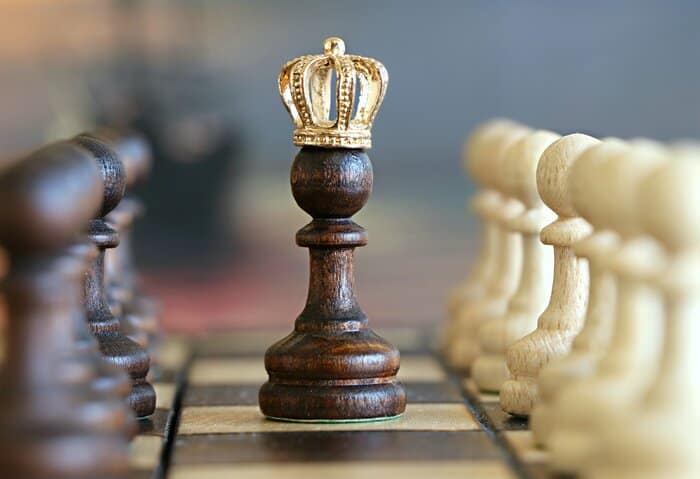
How to sell NFT art is somewhat covered in the process involved with making NFT art above. That said, there is one particular feature that I have to trumpet from the mountain tops!
ROYALTIES BABY!!!
Yes! That’s right! NFT’s now enable us as artists to embed our artwork with a specific percentage so that every time it gets resold after the initial purchase we can get a cut of the sale!
In the video above covering the process of how to get started making NFT’s he covers this topic at 7:58 seconds if you want to see what it looks like on the Rarible platform.
Needless to say, this is a HUGE gamechanger for the ENTIRE art world! As we have already touched on and briefly discussed, this doesn’t just apply to only digital pieces of art.
So far the artist I mentioned earlier, Trevor Jones, is the only artist I have found thus far applying it to real-world artwork but I have seen commenters on videos thinking the same thing. I sure as hell intend to figure out how to do this!
As a growing artist who has yet to sell any of his physical paintings, I think this would be an incredible thing to implement from the very beginning of my art career. This way as I get better, make a name for my self, and my artwork increases in value, I won’t have to miss out on the accrued value my earlier pieces will gain.
Plus, then I get the added benefit of seeing the life cycle of where my paintings go and who currently has possession of them as well as protect my work from possibly being stolen or forged. I really can’t see much of a downside to this!
When it comes to the percentage you can apply to your royalties it can be anywhere from 5% up to 50%. I’m not sure if you can go higher than 50% or if it’s just not reasonable to go higher than that.
In either case, once we figure out how to apply this to our canvas paintings we will be able to earn royalties for life!
I don’t know about you but I am ALL ABOUT those residual streams of income and building them in whatever ways that I can! Heck, that’s a big part of what this website and my YouTube channel are all about.
How to Display NFT Art and Why It’s So Cool!
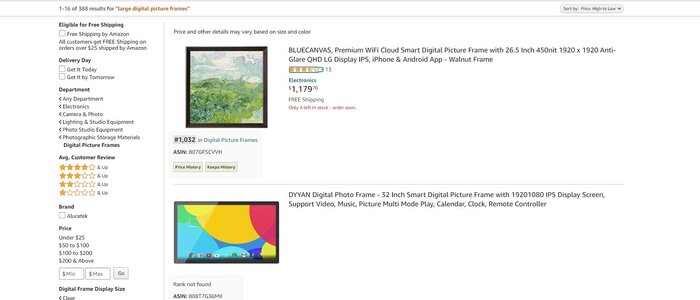
Now, once you spend some time exploring this wild and crazy world of Nifties, you’ll see many of them are moving images with sound.
You may be wondering why would you want to spend several thousand dollars on something like this if you can’t hang it on your wall in your home for your visitors to enjoy. Well, the truth is you absolutely CAN do this!
There are many NFT pieces of art that are static images that you could simply have printed on canvas so that you can hang them. This would be one way to hang this type of artwork so you can enjoy it casually as you live your daily life.
This of course doesn’t fully embody the magic that can be had with NFT artwork that moves. If you want more of that Harry Potter like magic of moving artwork in your home the next best option is to use a digital frame or a T.V.
They do make digital frames of all sizes and if you have the money to buy an awesome NFT you likely won’t mind shelling out a few hundred dollars for a great digital frame or T.V. to display it in.
Click the link below to see the largest digital frames currently available on Amazon!
Largest Digital FramesBy using a digital frame like the ones seen in the link above you can display your awesome NFT art in whatever home or business you might like to show it off in!
Let’s go just a step further though! It doesn’t end with digital frames!
The next way you will be able to display your art is through the use of Augmented Reality. At the time of writing this article Augmented Reality is not yet used widely and regularly by the average population.
That said, we are very very close to that happening. Within the next few years some company will release augmented reality glasses or contact lenses that will lace the digital world with our physical world permanently and forever.
I have my money on Apple taking the cake on that market but I’m sure there will be many other options as well.
When wearing AR Glasses and contact lenses becomes common place it will be easy to display your NFT art pretty much anywhere you might like to! You won’t have to lug around any digital frames like the ones linked above and will be able to place your prized possession wherever you want at will in the places that you live and work.
Are you ready for the whacky and wonderful world that is emerging all around us?!?
Is NFT Art a Good Investment?
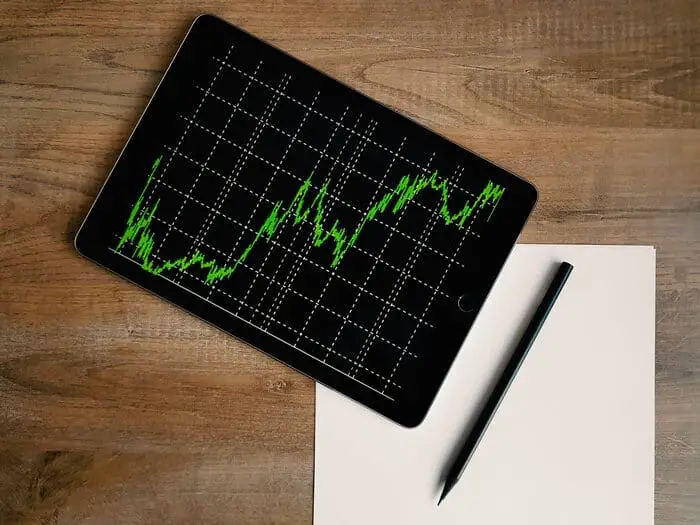
Now we get to the final question that is likely on the mind of many. Especially right now while the hype is HUGE!
Is NFT art a good investment or am I taking a risk?
First off, I have to put all the normal disclaimers here, I’m not a financial advisor and know very little about how to assess the quality of investments like these. So please take anything I have to say here with a grain of salt and do your research to see what others that are more versed in these matters than myself have to say.
Second off, can you name any sort of investment opportunity or purchase that doesn’t have some level of risk involved? That said, there are some valid things to be concerned about and to consider.
I’ve done my best here to cover ALL of the things you NEED to know about prior to investing or even creating NFT art.
Where is the Data Stored and Maintained?
One common concern and issue that seems to need to be addressed is how to ensure what you’re buying will remain available. It took me some serious digging and the flexing of all of my Google-Fu skills to find any information in relation to this concern.
I read almost every article I could find on NFT’s to try and figure out what the major concerns are with them. There is far too much content out there right now that doesn’t even mention any of the most glaring issues.
That said, there were a few that mentioned bit rot which finally lead me to what I was looking for. The article titled “Who Is Responsible for NFT Data?” finally gave me the information I desperately was searching for in order to share with you.
No matter what the object of value is that we are seeking to purchase and own, there will always be some level of degradation involved in the course of ownership. Keeping a piece of artwork preserved takes time, effort, and investment.
Everything in the universe is subject to entropy. Bits of data are not exempt from this problem! Bit rot is what happens when bits decay. You can check out the wiki on bit rot here.
The more pertinent issue to discuss is where the data is ultimately stored.
According to the article linked above, the blockchain is only good at storing tiny bits of data. So while the blockchain is where the NFT is stored that represents the artwork, the bulk of the data that represents the artwork is stored off-chain and hosted at a URL. This means that the data behind the URL CAN potentially change unexpectedly.
What happens to the ownership of an NFT when the place where the data is being stored shuts down?
The answer is that the owner might find themselves without access to something they paid A LOT of money for. I foresee, many lawsuits popping up as a result of this oversight not being discussed enough.
When this happens who gets sued? The original creator? The marketplace the NFT was sold on? This is all so new that there essentially aren’t adequate laws to cover it.
It might be interesting to send this over to Legal Eagle and get him to do a video on this!
In the real world, when a physical piece of artwork exchanges hands the responsibility for maintaining that piece of artwork is then transferred to the newest owner. This isn’t currently the case in the NFT world and there isn’t enough transparency around the issue of where the data for the art is actually being stored.
It seems the major solution being discussed and proposed in the above-referenced article, as well as this article here by Coindesk, is something called the InterPlanetary File System. (IPFS)
Calm down my fellow space cadets! It’s not quite what it sounds like!
The IPFS is a way of storing data that is sort of like BitTorrent where the data is stored across a network of computers where each computer holds a portion of the overall data. Making access to the data far more secure and robust.
This article is already far too long and overwhelming to delve into this any more deeply but it seems like a potential solution to this problem.
The article “Who is Responsible for NFT Data?” proposes a solution where the original creator sells the artwork with a “warranty” that guarantees the creator will maintain the data for a specified amount of time. Once the warranty expires the creator then would transfer ownership of the data to the current owner of the NFT at that point in time.
The owner can then transfer the data to a node on the IPFS network that they own and have control over.
Personally, I don’t know why we would have the warranty period at all if this is possible and easy to do. Why not just allow the data to exchange hands the same way we would a physical item at the point of purchase?
Ultimately, if you are looking to create or invest in NFT art in any way you should be aware of this issue and be assessing where your data is stored to ensure the longevity of your investment or creations.
I would recommend that if you do purchase an NFT that you address this issue with the seller right away to ensure the longevity of your purchase.
Be Aware of Potential Copyright Infringements
Right now, the crypto art boom is causing a massive amount of interest in the NFT marketplaces.
With increased interest comes opportunity seekers looking to take advantage of the ignorant to make a quick buck. Perhaps I quick million or two!
While NFT’s are designed to authenticate a piece of digital art, there are already cases of people stealing the artwork of others and attaching an NFT to it to claim it as their own when it really isn’t.
There are plenty of examples of this already in most marketplaces. Especially when it comes to pictures of celebrities. I’m sure the photographers of those pictures will have some real issues when they find out how much their work is being sold for without their consent or knowledge.
The marketplaces that host this artwork for sale don’t yet have any mechanisms, at least that I’m aware of, that help to address this issue. There are some ideas floating around but nothing concrete yet.
Beyond just this issue, each NFT is endowed with an NFT License. There is one aspect of the NFT license I find particularly disturbing as a creator.
According to the resource linked, an owner of an NFT of your artwork could potentially put it on their own products and sell it while earning up to 100k before they have to go back to the artist to negotiate royalty fees for further sales.
I don’t think the royalties we mentioned earlier in the article would apply to this but if this is something that is possible I think that the original artist should get a cut if someone were to do that with their art.
I don’t think that is very fair to the artist at all if they don’t. It feels to me like yet another way to take advantage of the hard work we put into building our skills up to make these things.
Then someone who has money can come along and buy MY creation and make more off of it than me without giving me a cut?
I don’t know about you but that just doesn’t feel right to me. Especially since one of the most appealing aspects of NFT’s is retaining some level of equity in your creation and building streams of residual income from it.
There are very clearly many legal issues that are going to arise very soon from this sudden BOOM in NFT art.
Carbon Emissions and Energy Consumption
Finally, the last problem we should discuss that may be of some importance to you if you are at all environmentally conscious is the issue of carbon emissions.
I came across several articles in my research discussing this issue. The first one I read was this one here by Everest Pipkin. Allow me to spare you the neck pain of having to look up at this person as they preach to you from their ridiculously high horse.
Despite my frustration with this person’s level of disdain for the crypto market and the underlying infrastructure that makes it possible, they do have some valid criticisms that must be considered.
While they quantify the amount of energy usage that the entire crypto network consumes and some of the glaring problems with it, they never once attempt to quantify the actual carbon emissions produced as a result of crypto art while looking down their incredibly long nose at it.
For the record, this person states that the entire blockchain network consumes somewhere around 24.43 TWh of energy. I have no idea how they are generating this number. They give no references or citations to know.
Do I agree that we should be concerned by the potential carbon emissions from a technology that requires ever-increasing amounts of power to sustain what is essentially engineered scarcity into a system of digital items that should remain limitless? Sure. It’s kind of crazy to force things to be scarce unnecessarily.
That said, we already live in a world where that happens. It’s called Capitalism. We could potentially produce everything everyone could ever need in a massive abundance but the profit motive makes us make things scarce that don’t necessarily need to be scarce.
That said, they wrote a scathing 5000-word article, which was very painful to read, just pointing out why EVERYONE else was wrong about the ways to combat or mitigate this issue. Their only solution at the very end of the article is to be a Luddite out of some sense of moral superiority.
The solution they propose is to just stop consuming. Ya. Good luck with that!
We live in a world of advancing technologies. Get used to it because it’s only going to accelerate. The genie is out of the bottle and no amount of you or I reducing our consumption is going to impact that.
The only way to solve the problem is to press forward and continue to advance not just the underlying technologies that make this system possible to be less energy-intensive. We need to make our electrical grids less carbon-intensive and our supply chains less carbon-intensive.
Then we need to use the very technology this person is poo-pooing to make better use of the resources we have.
The blockchain itself will undoubtedly make ever-increasing levels of crowd sharing possible thus reducing the number of resources needed to produce the items that bring us comforts. It will make access to many goods preferable over ownership. I’m not entirely sure that the NFT is that thing on the blockchain that will do it but I suspect it has a role to play.
While I wholeheartedly agree with many of the progressive policies they highlight toward the end of the article, not a single one of them has anything to do with this technology.
I still retain they have some valid criticisms that are worth a read but the snobbery about it left a bad taste in my mouth. I can’t really recommend it unless you’re in the mood to be pissed off.
That said, their anger is righteous and comes from a place of caring deeply about the future of this planet. For that I commend them.
A much more tasteful read and critique of this issue, which actually does attempt to quantify the carbon emissions of a batch of NFT art is this article here by Joanie Lemercier.
Joanie is a french artist who is actively trying to take what I would consider being a more leveled and reasonable approach to this issue. He has been seeking to reduce his carbon footprint by 10% every year. He’s not so unreasonable as to expect a huge rapid reduction in personal consumption.
After engaging in the NFT market and making his first NFT Art Drop, he began to get more curious about the energy consumption involved and the potential carbon emissions related to his work.
As an artist who works primarily with light, I can see why this is an issue of greater concern in his work. Not that I don’t care about these things, clearly I do, I’m just a realist who realizes the problem needs to be addressed at the largest scales first.
If I’m making changes but the 100 major companies most responsible for the world’s carbon emissions are doing nothing, it’s like pissing on a forest fire. The problem is more systemic than it is personal.
That said, I have a much higher level of respect for his analysis and approach to the problem.
First off, he is 100% correct that there is a severe lack of transparency provided by the market places hosting NFT Art for sale.
He states how in his first drop he had some awareness of the energy consumption involved in the process so he purposely kept his drop limited to 6 pieces. Making the works available in editions he had a total of 53 pieces he sold as NFT’s.
Afterwards he tried to contact Nifty Gateway to get some insight from them on this topic but didn’t receive ANY responses from them. I totally agree with him that this is problem that needs to be addressed.
Not only do marketplaces like Nifty Gateway need to be more transparent about their energy consumption but they need to provide artists with the data on how much energy and potentially related carbon emissions are involved with the creation of one single NFT.
Frustrated with their lack of response, Joanie then reached out to Offsetra to determine what the carbon emissions of his NFT work were. Together they came to the conclusion that each on of the 53 pieces of art were responsible for 80kg of CO2 per piece of artwork!
To put that in perspective for my American audience, 80kg is roughly 176lbs of carbon!!! While I’m not entirely sure how they calculated that, if this is true, that is certainly an enormous problem that needs to be addressed.
I hope that if you have made it this far in this article that you are now much more prepared to make an educated decision on whether or not you want to participate in the NFT marketplace.
Whether you’re a collector looking to buy or an artist looking to sell there are many factors to consider and I’m sure there are other issues that can possibly come up that I didn’t think to put in this article.
Whatever you do, proceed with caution and total awareness of the potential pitfalls that we were able to identify so far. Don’t get sucked in by the negative nancies and play your desired role in pushing this new frontier forward in a positive way!
